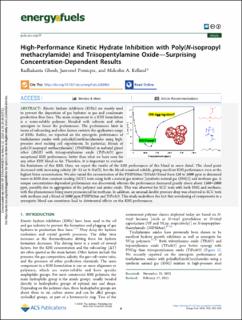| dc.contributor.author | Ghosh, Radhakanta | |
| dc.contributor.author | Pomicpic, Janronel Calog | |
| dc.contributor.author | Kelland, Malcolm Andrew | |
| dc.date.accessioned | 2023-05-03T08:08:22Z | |
| dc.date.available | 2023-05-03T08:08:22Z | |
| dc.date.created | 2023-03-24T14:53:03Z | |
| dc.date.issued | 2023 | |
| dc.identifier.citation | Ghosh, R., Pomicpic, J., & Kelland, M. A. (2023). High-Performance Kinetic Hydrate Inhibition with Poly (N-isopropyl methacrylamide) and Triisopentylamine Oxide─ Surprising Concentration-Dependent Results. Energy & Fuels, 37(7), 4928-4936. | en_US |
| dc.identifier.issn | 0887-0624 | |
| dc.identifier.uri | https://hdl.handle.net/11250/3065919 | |
| dc.description.abstract | Kinetic hydrate inhibitors (KHIs) are mostly used to prevent the deposition of gas hydrates in gas and condensate production flow lines. The main component in a KHI formulation is a water-soluble polymer, blended with solvents and other synergists to boost the performance. The performance limit in terms of subcooling and other factors restricts the application range of KHIs. Earlier, we reported on the synergetic performance of trialkylamine oxides with polyalkyl(meth)acrylamides using high-pressure steel rocking cell experiments. In particular, blends of poly(N-isopropyl methacrylamide) (PNIPMAm) in isobutyl glycol ether (iBGE) with triisopentylamine oxide (TiPeAO) gave exceptional KHI performance, better than what we have seen for any other KHI blend so far. Therefore, it is important to evaluate the limitations of this KHI. Here, we report the results of the KHI performance of this blend in more detail. The cloud point decreased with increasing salinity (0–15 wt % NaCl), but the blend remained soluble, giving excellent KHI performance even at the highest brine concentration. We also varied the concentration of the PNIPMAm/TiPeAO blend from 250 to 5000 ppm in deionized water in KHI slow constant cooling (SCC) tests using both a natural gas mixture [synthetic natural gas (SNG)] and methane gas. A unique concentration-dependent performance was discovered, wherein the performance decreased greatly above about 1500–2000 ppm, possibly due to aggregation of the polymer and amine oxide. This was observed for SCC tests with both SNG and methane, with the phenomenon being more pronounced for methane. In addition, an unusual double pressure drop was observed in SCC tests with methane and a blend of 5000 ppm PNIPMAm and TiPeAO. This study underlines the fact that overdosing of components in a synergistic blend can sometimes lead to detrimental effects on the KHI performance. | en_US |
| dc.language.iso | eng | en_US |
| dc.publisher | American Chemical Society | en_US |
| dc.rights | Navngivelse 4.0 Internasjonal | * |
| dc.rights.uri | http://creativecommons.org/licenses/by/4.0/deed.no | * |
| dc.title | High-Performance Kinetic Hydrate Inhibition with Poly(N-isopropyl methacrylamide) and Triisopentylamine Oxide─Surprising Concentration-Dependent Results | en_US |
| dc.type | Peer reviewed | en_US |
| dc.type | Journal article | en_US |
| dc.description.version | publishedVersion | en_US |
| dc.rights.holder | The authors | en_US |
| dc.subject.nsi | VDP::Matematikk og Naturvitenskap: 400::Kjemi: 440 | en_US |
| dc.source.journal | Energy & Fuels | en_US |
| dc.identifier.doi | 10.1021/acs.energyfuels.2c03963 | |
| dc.identifier.cristin | 2136751 | |
| cristin.ispublished | true | |
| cristin.fulltext | original | |
| cristin.qualitycode | 2 | |

